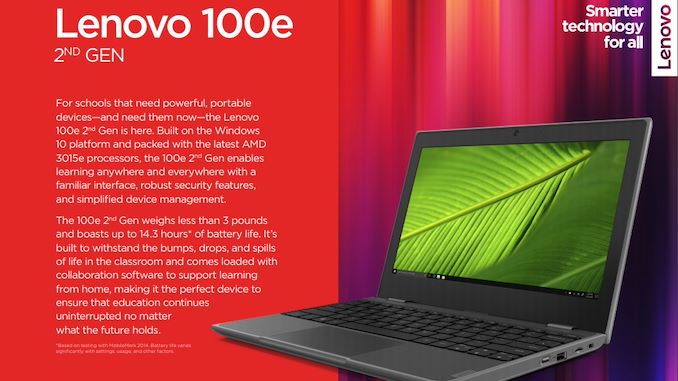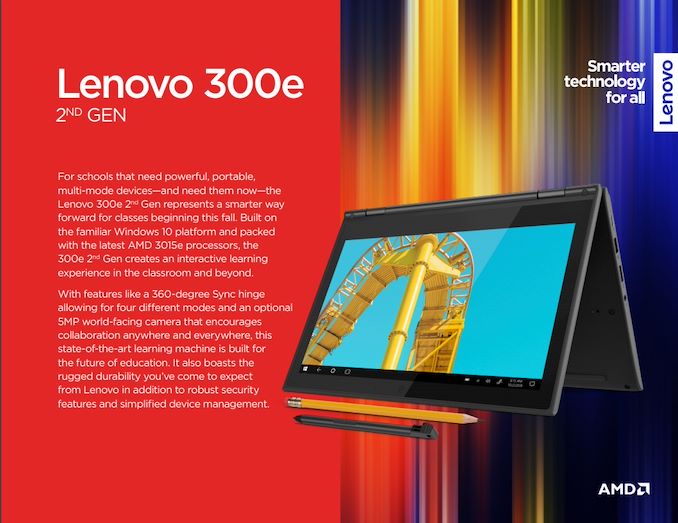AMD Zen now at 6W TDP: Dual Core for Education
by Dr. Ian Cutress on August 4, 2020 10:05 AM EST
At the low-end of AMD’s portfolio, the company uses Athlon Gold and Silver naming for parts that offer fewer cores and lower power consumption. These parts are still based on Zen or Zen+ microarchitecture, paired with a small amount of Vega graphics, indicating that this market is best served with something that is at a low-cost to manufacture but still of sufficient performance for the markets intended. Sitting below those Athlons, two new APUs have popped up in some new Lenovo education-focused designs today.
The two new processors dispense with the Athlon naming, as AMD gets right into it – the AMD 3015e and 3020e use the same lower case ‘e’ ending we last saw on a product line in 2011, indicating the super low power that these processors are rated for. These processors are given a TDP of 6W with two cores and Vega 3 graphics, traditionally what we see in low cost laptops but sufficient for education-style designs.
The silicon these new processors are based on, we believe, is AMD’s Dali silicon. It is the smallest of all AMD’s Zen APU silicon offerings, already in the market as AMD Athlon Mobile. These new parts come in below those specifications.
| AMD Dali-based Zen APUs | |||||||
| AnandTech | Cores Threads |
Base Freq |
Turbo Freq |
GPU | GPU Freq |
DDR4 | TDP |
| Athlon Gold 3150U | 2 / 4 | 2400 | 3300 | Vega 3 | 1000 | 2400 | 15 W |
| Athlon Silver 3050U | 2 / 2 | 2300 | 3200 | Vega 2 | 1100 | 2400 | 15 W |
| Athlon 300U | 2 / 4 | 2400 | 3300 | Vega 3 | 1000 | 2400 | 15 W |
| Athlon Silver 3050e | 2 / 4 | - | 2800 | Vega 3 | 1000 | 2400 | 6 W |
| AMD 3015e | 2 / 4 | 1200 | 2300 | Vega 3 | 600 | 1600 | 6 W |
| AMD 3020e | 2 / 2 | 1200 | 2600 | Vega 3 | 1000 | 2400 | 6 W |
If the set-up looks a bit odd, well, it is. The 3015e has simultaneous multi-threading but a much lower GPU frequency and DDR4 support compared to the 3020e. This might be the trade-off at the 6W power mode.
Lenovo is set to use the new AMD 3015e in two of its new education designs.
The Lenovo 100e 2nd Gen will use this new chip, Windows 10, Wi-Fi 6, 64 GB eMMC, 4 GB DDR4, an 11.6-inch 13x7 display (250 nits), but offer a hard wearing design suitable for bumps and scrapes as well as ~12 hours of battery life, with quick charging providing 80% power in an hour.
The Lenovo 300e 2nd Gen is a similar build but offers a 360-degree hinge, pen support, with an optional 128 GB SSD. Battery is 42 Wh, rated at ~12 hours.
The 100e will start at $219 and the 300e will start at $299, available from September. Both devices have a variety of student-focused software options focusing on teaching and security.











65 Comments
View All Comments
Jorgp2 - Tuesday, August 4, 2020 - link
Lol, no.That 1w/per core is the result of many cores sharing the same uncore.
It doesn't mean a 2core Zen 2 SoC will take 2w.
Spunjji - Wednesday, August 5, 2020 - link
No, but it does mean his supposition of a dual-core SoC at ~4W is probably quite reasonable.Personally I'd expect them to stick at the 6W TDP and reap the benefits of higher yields and higher clock speeds.
Sahrin - Thursday, August 6, 2020 - link
No, the 1W/core doesn’t include the north bridge at all. It’s just an expression of the efficiency of the core, ie, more efficient than Intel’s.Spunjji - Thursday, August 6, 2020 - link
Do you not agree that already having a dual-core 14nm CPU (plus northbridge) at 6W means that a dual-core 7nm CPU at 4W is at least feasible?xprojected - Tuesday, August 4, 2020 - link
The more I look at the 3015e specs, the less I think it is a Dali like the 3020e. It says socket FT5 while Dali is FP5, FT# being for the "ultra-mobile" CPUs. Its part number is totally different too. But, it's 14nm so it can't be a Carizzo or Stoney Ridge. Something new?xprojected - Tuesday, August 4, 2020 - link
OK, Google searching for AMD FT5 suggests it's called "Pollock".klatscho - Tuesday, August 4, 2020 - link
Hardwaretimes says you are correct -https://www.hardwaretimes.com/amd-pollock-5w-apus-...
Arbie - Tuesday, August 4, 2020 - link
And - it can probably run Crysis.ozzuneoj86 - Tuesday, August 4, 2020 - link
Would really like to see CPUs like these (preferably 7nm) built into inexpensive ITX boards for small project PCs, HTPCs, etc.Places that sell boards like that are still carrying Intel "J" series and AMD APUs... yuck.
Jorgp2 - Tuesday, August 4, 2020 - link
Why?This would perform similarly